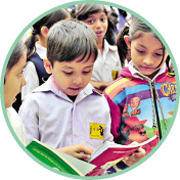
Children's education more expensive than ever
Wasi Ahmed | Wednesday, 22 May 2024
 In recent years, the cost of children's education in Bangladesh has soared to unprecedented levels, surpassing that of neighbouring countries. While this might initially seem indicative of commendable parental investment, the stark reality reveals a different narrative: the burgeoning reliance on private educational institutions is significantly straining the pockets of parents and guardians. According to the UNESCO Global Education Monitoring Report 2023, Bangladeshi households shoulder a staggering 71 per cent of the total expenditure on their children's education. This financial strain is exacerbated by the exorbitant fees and expenses associated with private schooling, which are three times higher than those of government institutions. Expenditure is nearly nine times higher in private kindergartens.
In recent years, the cost of children's education in Bangladesh has soared to unprecedented levels, surpassing that of neighbouring countries. While this might initially seem indicative of commendable parental investment, the stark reality reveals a different narrative: the burgeoning reliance on private educational institutions is significantly straining the pockets of parents and guardians. According to the UNESCO Global Education Monitoring Report 2023, Bangladeshi households shoulder a staggering 71 per cent of the total expenditure on their children's education. This financial strain is exacerbated by the exorbitant fees and expenses associated with private schooling, which are three times higher than those of government institutions. Expenditure is nearly nine times higher in private kindergartens.
The report refers to the preference of households for private schools to government schools. The UNESCO, in association with BRAC, launched a national programme, which is the first of its kind to study the private sector's role in education sector in South Asia.
According to the report, Bangladesh has the largest number of students in the private sector in South Asia. Some 94 per cent of the country's secondary school students are from private institutions. Sri Lanka has the highest number of private school students in pre-primary education (80 per cent), followed by Bangladesh (55 per cent). On an average, Bangladesh has the most private sector dependence in the education sector. The report found that despite making great progress in the access to education in South Asia, investment in education by the governments has remained insufficient. Except for Bhutan, no other country in the region has ever spent anywhere near 15 per cent of the total government spending or 4.0 per cent of the GDP on education. During the 10-year time span from 2010 to 2020, Bangladesh, Pakistan and Sri Lanka spent less than 2.5 per cent of their total GDP on education. Quality and relevance of education have therefore become a concern, says the report.
The prevalence of private education over public institutions can be attributed to the substandard quality of government-run schools, particularly at the primary and secondary levels. For many households, opting for private education is not a luxury but a necessity driven by the dire state of public schools. However, this comes at a considerable cost, often forcing families to make sacrifices in other essential areas of expenditure.
The root cause of this educational crisis lies in the rampant commercialisation of the sector, where private investors prioritise profit margins over societal welfare. Despite hopes that private institutions would supplement tuition fees with philanthropic support, the reality paints a starkly different picture. Most private educational entities operate as profit-driven ventures, exacerbating the educational disparity between affluent and marginalised communities. Meanwhile, the declining standards of public education, attributed to teachers' incompetence and inadequate resources, further perpetuate the cycle of private sector dominance. While sporadic government initiatives aim to address these challenges, the overarching failure to revitalise public education continues to fuel the demand for private alternatives.
The escalating cost of private education in Bangladesh not only strains family finances but also exacerbates socioeconomic inequalities. Affluent families can afford the hefty fees of private institutions, ensuring their children access quality education. However, for economically disadvantaged families, these expenses represent a significant financial burden, often leading to prioritisation of education for only select children or none at all. Consequently, this perpetuates a cycle of poverty, where access to quality education becomes a privilege reserved for the wealthy.
Moreover, the disparity between private and public education widens the gap between urban and rural communities. Private institutions are predominantly concentrated in urban centers, leaving rural areas with limited educational opportunities. As a result, rural students are deprived of the same educational standards and resources enjoyed by their urban counterparts, further entrenching regional disparities.
The proliferation of private institutions not only diverts resources away from public education but also undermines the accountability of the government to provide quality schooling for all. As the demand for private education grows, there is less pressure on policymakers to address the systemic issues plaguing public schools. Consequently, public education infrastructure continues to deteriorate, increasing the reliance on private alternatives.
Central to any educational reform effort is the empowerment and professional development of teachers. Inadequate teacher training and support contribute to the declining standards of public education. Investing in comprehensive teacher training programmes and incentivising qualified educators to work in underserved areas can help bridge the gap between public and private institutions.
While private education plays a significant role in meeting the demand for schooling, it should not come at the expense of neglecting public education. Government intervention is crucial to rebalance the education landscape and ensure equitable access for all children. This may involve increasing public investment in education, implementing stricter regulations on private institutions, and fostering collaboration between the public and private sectors to improve educational outcomes.
The escalating cost of private education in Bangladesh is symptomatic of broader systemic challenges facing the country's education sector. Addressing these challenges requires a multifaceted approach that prioritises equitable access, quality, and affordability.
wasiahmed.bd@gmail.com